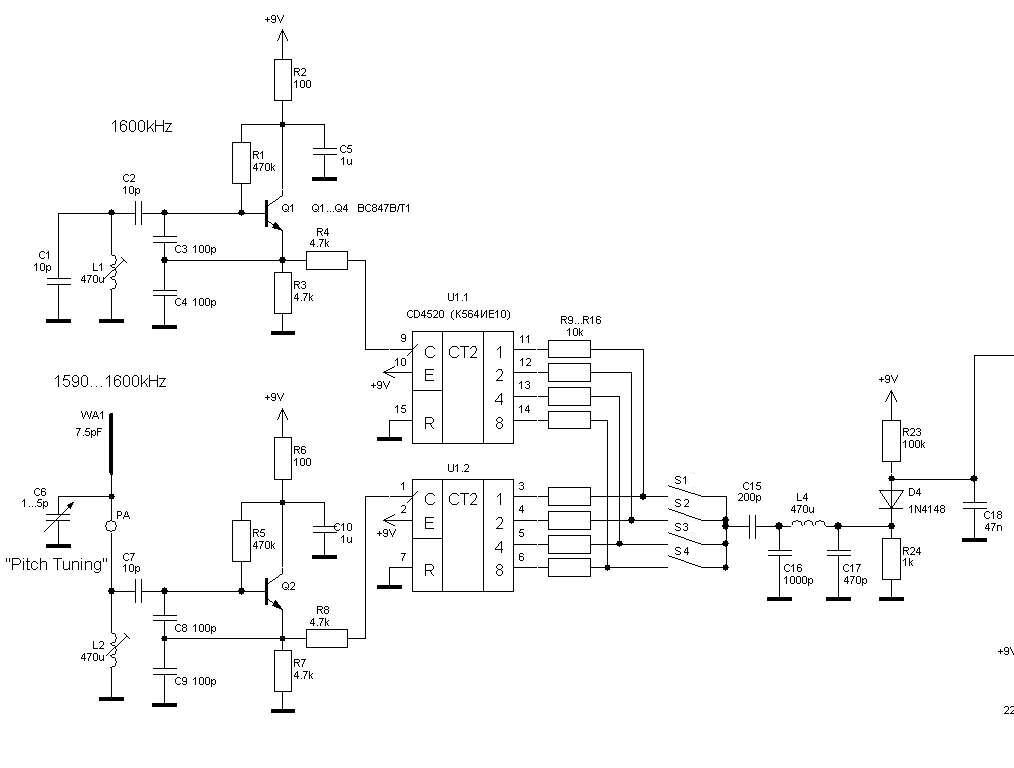"And perhaps level shifting?"
dewster, good news...
Your Clapp oscillator drives the dual counter IC K564ИE10 (the russian equivalent of CD4520) directly! As a bonus that IC helps decoupling oscillators without additional buffers.
"And perhaps level shifting?"
dewster, good news...
Your Clapp oscillator drives the dual counter IC K564ИE10 (the russian equivalent of CD4520) directly! As a bonus that IC helps decoupling oscillators without additional buffers.
"FredM was shocked about the (in his eyes) destruction of the beautiful oscillator waves by the comparators which transform them into simple +5V square pulses and about the further processing in cheapest CD40xx digital cmos ICs." - Thierry
I'm not an expert on heterodyning, but won't mixing squares give you a triangle waveform?
I've actually come to like the pure sine sound, and would want my Theremin to be able to do one (and mine does!). I suppose a tracking low pass filter...
"BTW: Indirect sound generation via VCO as done by Moog in the Series91 and Ethervox Theremins is not forcibly inducing latency as these both excellent instruments prove."
If there is a schematic, you might be able to do some simple analysis to determine the dominant lower pole. Honestly, most people wouldn't be aware of a 10Hz or so cutoff, though somewhat higher is better.
"As I could observe, not only in the Theremin domain, latency comes mostly from lousy coding in digital designs, be it by over-filtering things to mask design flaws or by proceeding samples blockwise instead of real time, the hardware requirements are much cheaper then..."
Yes. I sample the antennas at 2x (via DDR) their operating frequency of 196.666 MHz, or almost 400 MHz, and I do this partially because interfering RF 1/2 below this (Nyquist) this is linear and therefore can be minimized via filtering. The digital front-end is not the place to be cutting corners, garbage in/out. Aliasing can and does happen even in things like digital PLLs, where people aren't generally thinking in those terms.
Yesterday I was going through the private correspondence between FredM and myself, and he had an interesting and amazingly simple shielded antenna working off of a +/-15V op-amp. Reportedly his daughter could wave her hand around quite closely on the other side and not disturb his playing at all. He said SNR for the lower antenna swing seemed as good as a 50V swing, which I can believe. And for my own stuff I'd love to get rid of 1/2 of the intrinsic C...
OT, but I think I "get" more of where he was coming from regarding his belief in predestination. More of a practical than mystical thing in his head. We're all pretty much stuck being us and acting that out.
Thierry, I wish I could teleport you here for an afternoon, I'd be quite interested in your reaction to how far I've gotten, what might be improved, etc.
"Your Clapp oscillator drives the dual counter IC K564ИE10 (the russian equivalent of CD4520) directly! As a bonus that IC helps decoupling oscillators without additional buffers." - ILYA
You could probably leave the output PNP buffer off as well, though I like the way the two opposite types take current in turns, producing a fairly constant load. Why a counter, for octave switching? If so, perhaps use 3 or 4 XORs for simultaneous mixing and pick the one you want. A counter would also let you use a higher antenna frequency, and therefore a much smaller (value and physically) inductor, correct?
(For digital coupling in general I've been partial to capacitive coupling to an inverter that has a small amount of negative feedback, which auto-centers to the input threshold voltage. I could probably do this right at the FPGA pins if I wanted to, making a high performance Theremin with just two coils, 4 caps, and 2 feedback resistors; plus maybe 4 transistors and 2 resistors for drive follower buffering and guaranteed lock; plus an ESD chip; plus...)
- dewster,
yes, to use higher frequencies (primary task).
The XOR (as well as OR/AND) operation isnt a good choice due "plastic sounding". For me, it is a sign of bad design. I'm surprised that Moog used it.
OT: after dividers I'm filtering the squares (cutoff freq is around 300 kHz) and feed the mix to detector. Register/timbre is set by S1-S4 . At the moment the PCB is assembled, checked and waiting for housing.

"yes, to use higher frequencies (primary task)." - ILYA
Around 1.6MHz, yes? I've often wondered about skin effect - and human skin effect (!) - in terms of capacitive interaction, there have been "fruit ripeness" meters based on this, but I have no idea where the threshold starts kicking in. Electroglottography uses ~1.5MHz IIRC if that means anything.
"The XOR (as well as OR/AND) operation isnt a good choice due "plastic sounding". For me, it is a sign of bad design. I'm surprised that Moog used it."
I find odd harmonics alone kind of grating, though a triangle sounds smooth enough to be OK I suppose. I would guess they don't happen in nature all that often.
"OT: after dividers I'm filtering the squares (cutoff freq is around 300 kHz) and feed the mix to detector. Register/timbre is set by S1-S4 . At the moment the PCB is assembled, checked and waiting for housing."
Makes sense. When I was searching the web for square wave heterodyning I ran across many instances where pre-filtering was necessary. Good luck, and please report on your progress!
You must be logged in to post a reply. Please log in or register for a new account.